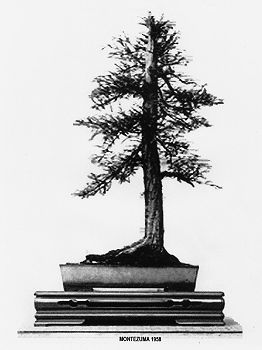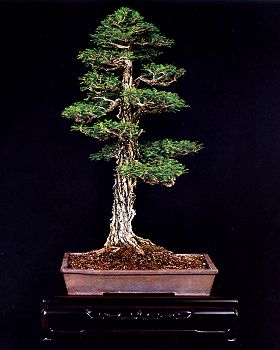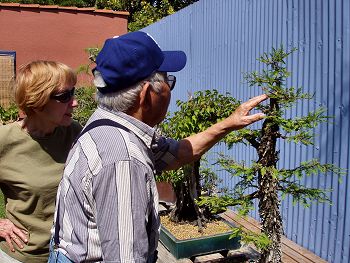
John working on his Montezuma in the late 1950s.
Larger version
We end at the beginning: the last John Naka bonsai donated to the National Arboretum in Washington, D.C. was his very first bonsai. Our story begins at the end of 1946 when John moved his family to Los Angeles from Colorado. The mild climate gave John the opportunity to work as a landscaper year round. Several months after settling his family into their new home, John decided to resume the art of bonsai he had learned from his grandfather in Japan. In the winter of 1947, he went shopping for material.

John knew that his first tree should be a formal upright – the perfect style to practice basic elements of bonsai design and techniques. But what kind of material should he use? The foemina juniper with its naturally straight trunk would be perfect. And in the years to follow, he worked on many foemina junipers, eventually combining several to create “Goshin.” But one aspect of the evergreen foemina is its “sameness” throughout the year. For his first tree, John wanted to express all seasons.
John fondly remembered the seasonal changes that accompanied the more dramatic weather fluctuations he experienced in Colorado and Japan. But the mild weather in Los Angeles left most of the landscape green all year. He therefore sought out material suitable for a formal upright, yet with the characteristics that would give his first bonsai greater visual interest throughout the year. The Montezuma cypress was the perfect material – pale green spring growth turning deep green in summer, bronze foliage in the fall, and the barren winter silhouette showing off the structure of the tree.
John found his treasure in the back of a nursery, amid overgrown and unwanted stock. This particular tree caught his attention for three reasons: the straight trunk, the interesting rootage, and the hollow that gave the tree more character and evoked age. Over the years, the size of the trunk and the height of the tree remained the same, but the trunk was enhanced with development of the most beautiful rough bark.

For the next 57 years, John shaped and refined the apex and branches, and the tree developed a majestic quality that only time can create. But John was always looking to the future... always driven to improve his trees... always mindful of the ever-changing aspect of this art. At 89 years young, John decided to redevelop the apex and branches. The old apex was removed, an upper branch was positioned in its place, and most branches were cut back to just a couple of inches. Although it will take many years of development, John's vision of better taper and refinement will eventually be realized.

In Japan, bonsai are passed from generation to generation. John learned about this art from his grandfather – and passed on his love of bonsai and collection of trees to his grandson Mike, who understood the significance of this very special tree. Mike felt the proper place to showcase John's legacy was in the John Naka North American Pavilion, where five other cherished Naka bonsai live. In the spring of 2004, I took both the Montezuma cypress and John's Eleagnus to my home to prepare them for shipment to the Arboretum.
On April 26, 2004, Marybel Balendonck brought John and Alice Naka to my home. John examined both trees, gave some last-minute directions before the trees were to be crated, and bid them farewell. At that time, I took a few pictures of John saying goodbye to his very first bonsai.

Little did I know that these would be the last photos taken of him. Two weeks later, John went to the hospital – and on May 19th, we began grieving. John is no longer with us, but his trees are. The charm, the wisdom, and the dedication of John Naka live in his bonsai, in his books, and in our hearts.
[ Top of page | Go back | Go forward | "Profiles in Bonsai" contents | Site contents | Home | ]